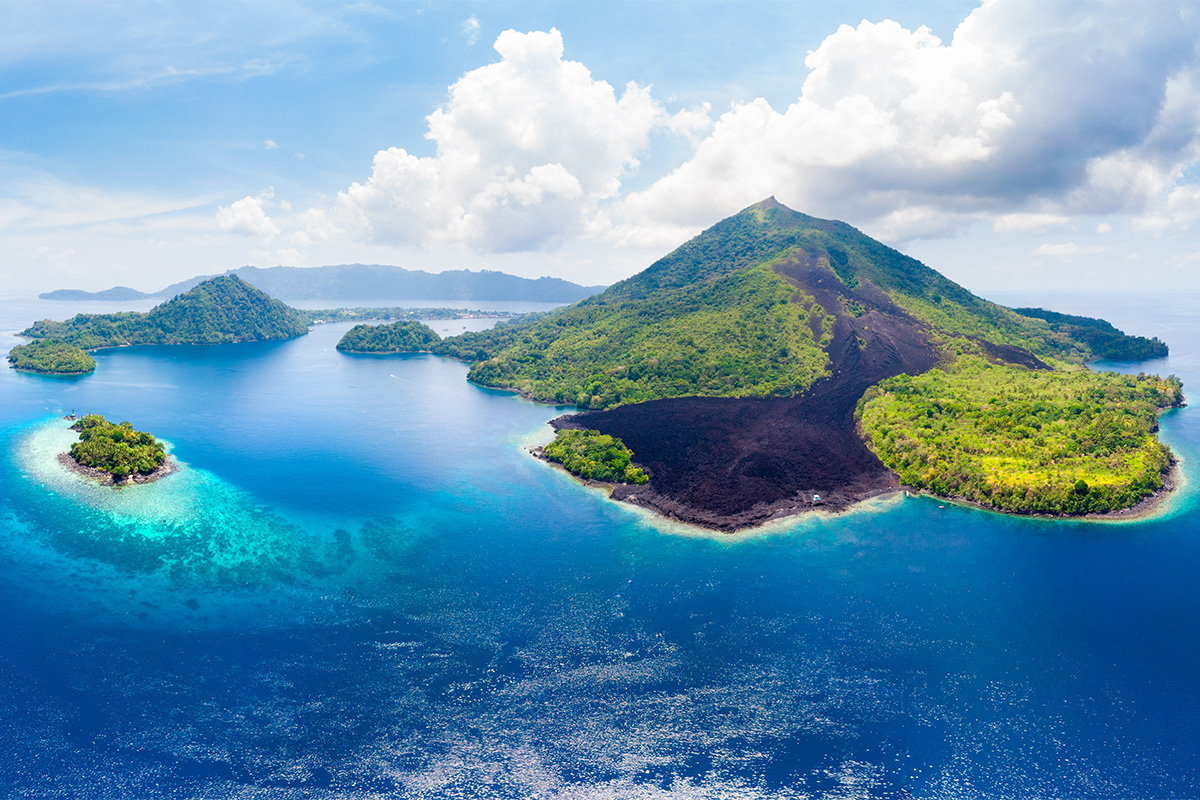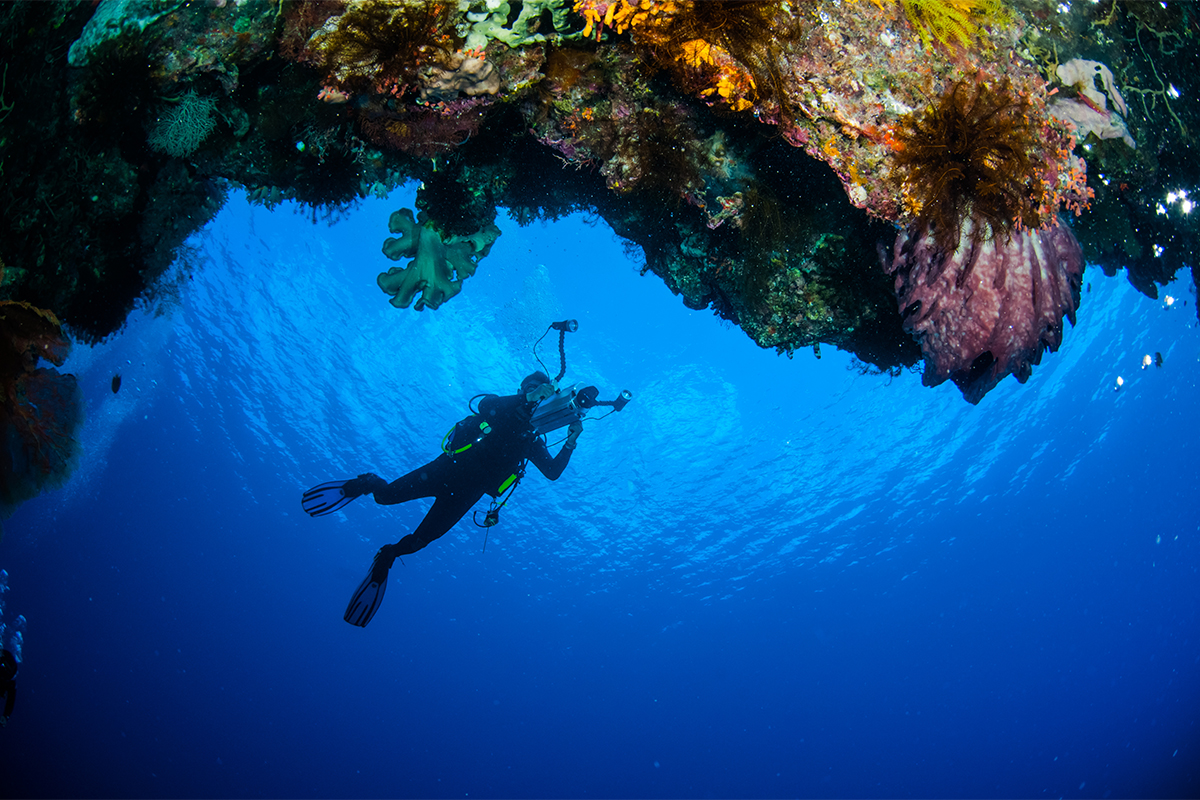Raja Ampat & Banda Islands
This trip offers diving in completely different areas: Raja Ampat and the Banda Sea – the biodiversity that you can witness here's amazing!
Typically operating in select months when dive conditions in the Banda Sea are optimum, this varied itinerary allows divers to explore Raja Ampat's pristine reefs, encounter diverse marine life in the Banda Sea, and dive Ambon's world-class muck sites.
The variety of marine life can be astounding, offering encounters with enormous schools of fish and regular sightings of sharks, manta rays and turtles. The islands are mostly uninhabited, with only the faint glow of a few night lights from small villages and fishing boats on the horizon and this lack of population pressure ensures abundant marine life and vibrant habitats.
In the Banda Sea, divers are treated to an explosion of marine life on the pristine reefs, as well as steep drop-offs, huge schools of fish, a plethora of pelagic species, sea mounts and critters galore. Your liveaboard voyage will give you the opportunity to dive some of the best sites in Indonesia.


ITINERARY HIGHLIGHTS
- Dive the historic sites of Banda Islands, offering stunning walls, pinnacles, and muck diving opportunities.
- Experience the world-class muck diving of Ambon Bay, home to a variety of rare and unusual creatures.
- Discover the pristine soft coral reefs of Misool, a hidden gem of Raja Ampat.
- Explore the diverse dive sites of Dampier Strait, teeming with schools of fish, manta rays, and sharks.
Dive regions you may explore on this itinerary include:
Dampier Strait: The best known dive sites are Cape Kri, Sardine Reef, Chicken Reef, Mioskon, Blue Magic, Mikes Point, Manta Sandy, Arborek Jetty, Mangrove and Citrus Ridge. All the dive sites around the Strait are known for the huge amount of schooling fish; barracudas, bigeye trevallies, oceanic triggerfish, spadefish, surgeonfish, and snappers. Apart from schooling fish, this is an area where we get to see blacktips, whitetips, and wobbegongs sharks. Some of the best manta dives are here at Manta Sandy and Blue Magic. Manta Sandy is a sandy slope with several bommies that the mantas use as a cleaning station. Blue Magic is a small pinnacle where giant mantas congregate for cleaning. Some of the best mangrove dives are also located in the Strait, around the islands of Yanggefo and Gam. The area is also well known for the bommies found in shallow areas of the reefs. Some of these bommies are covered with beautiful soft corals and host a profusion of glassfish. Of course, we can't forget the dive sites in some of the local villages, where the pillars of the jetties are covered in soft corals and small critters.
Misool: The most southern island in Raja Ampat is surrounded by several hundred small islands and rocks. Some of the nicest soft coral reefs in the world are located in Misool. It is impossible to describe only several dive sites, since there are literally hundreds of them. Every year new dive sites are discovered around Misool. Many of the dive sites around Misool are just as fishy as the ones from the Dampier Strait, with the same schools of barracudas, spadefish, pinjalo snappers, and zillions of fusiliers. But Misool is also a great macro place. It's known as the kingdom of the pygmy seahorses, as well as having small allied cowries in the gorgonian seafans, and nudibranches. Within each of the following areas, there are always several dive sites. Wagma, Farondi, Balbulol, Sagof, Daram, Yellit, Boo, Warakaraket, Fiabacet, Kalig, Wayilbatan, Wayil, Pele and Nampele (Blue Water Mangroves).
Pulau Koon: A small island on the southeast of Ceram, halfway between Raja Ampat and the Banda Islands. There are walls covered in soft corals, and sandy slopes with hard coral bommies, but the most interesting feature is the amount of schooling and pelagic fish; barracuda, bigeye trevally, red snapper, pompano, batfish, and giant grouper.
Manuk: An extinct volcano about 65 nautical miles south of the Banda Islands, is one of 2 places in Indonesia where there are huge aggregations of sea snakes, Chinese sea snakes and banded sea kraits, it's an incredible experience to be surrounded on all sides by these creatures. The island is surrounded by black sandy slopes with hard coral reefs, volcanic ridges covered in gorgonians with zillions of fusiliers and pelagic fish such as Spanish mackerel and dogtooth tuna.
Pulau Nila: Approximately 26 nm northeast of the island of Nila in the Banda Sea, is a submerge reef called Nil Desperandum, consisting mainly of walls and steep slopes going several thousand meters deep, with beautiful hard corals on the reef top. The reef is several miles long; Napoleons, turtles and reef sharks are usual sightings here. Five nautical miles east of Nila there is an atoll called Dusborgh with similar topography, its crystal clear water makrd it another great place to see pelagic fish, tuna, mackerel, jack and rainbow runners passing by.
Banda Islands: Also known in the old days as the Spice Islands, many of the dive sites around the Bandas are wall dives covered in massive gorgonians, soft corals, barrel sponges with some very interesting swim-throughs. Other attractive dive sites feature pinnacles with enormous groups of schooling pyramid butterflyfish, triggerfish and pelagic fish such as tuna passing through, spectacular hard coral reefs next to the volcano and great muck dives with lots of Mandarin fish in the local jetty. The Banda Islands, however, offer much more than diving, they are a cultural and historical experience.
Ambon: Off the beaten track, Ambon island is home to a number of clear water dive sites, but it’s Ambon Bay which has emerged as a world-class muck diving location. For the few who travel here, the rewards are immense. The dive sites range from black sand and rubble to jetties and wrecks, all home to a prolific marine life including but not limited to rhinopias, frogfish, octopus and seahorse. In contrast to the muck of the Bay, the clear water sites on the south and east coast offer a spectacular topography with seamounts, caves and archways adorned with soft corals. It’s at these you can expect to see larger pelagic species such as Napolean wrasse, shark, ray and grouper.
Nusa Laut: A small island, next to the island of Saparua with some beautiful hard coral fringing reefs as well as walls similar to those of the Banda Islands.
EXPERIENCE REQUIRED: You must be an Advanced Open Water diver or equivalent and have logged a minimum of 50+ dives to join this safari.